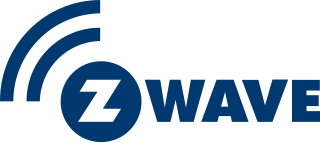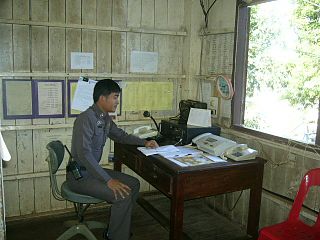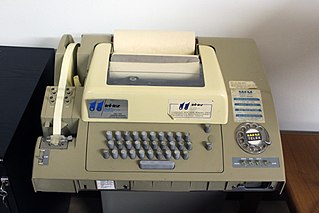Related Research Articles
The early history of radio is the history of technology that produces and uses radio instruments that use radio waves. Within the timeline of radio, many people contributed theory and inventions in what became radio. Radio development began as "wireless telegraphy". Later radio history increasingly involves matters of broadcasting.
Interoperability is a characteristic of a product or system, whose interfaces are completely understood, to work with other products or systems, at present or in the future, in either implementation or access, without any restrictions. While the term was initially defined for information technology or systems engineering services to allow for information exchange, a broader definition takes into account social, political, and organizational factors that impact system-to-system performance. Hence, interoperability involves the task of building coherent services for users when the individual components are technically different and managed by different organizations. Types of interoperability include syntactic interoperability, where two systems can communicate with each other, and cross-domain interoperability, where multiple organizations work together and exchange information. In any collaborative effort, cross-domain interoperability is important because a lack of communication can cause misunderstandings and greatly reduce efficiency. This would especially be a problem in organizations that are meant to respond to emergencies as quickly as possible, such as law enforcement, fire fighting, EMS, and other public health and safety departments.

9-1-1, also written 911, is an emergency telephone number for the North American Numbering Plan (NANP), one of eight N11 codes. Like other emergency numbers around the world, this number is intended for use in emergency circumstances only, and using it for any other purpose is a crime in most jurisdictions.
Plain old telephone service (POTS), or plain ordinary telephone system, is a retronym for voice-grade telephone service employing analog signal transmission over copper loops. POTS was the standard service offering from telephone companies from 1876 until 1988 in the United States when the Integrated Services Digital Network (ISDN) Basic Rate Interface (BRI) was introduced, followed by cellular telephone systems, and voice over IP (VoIP). POTS remains the basic form of residential and small business service connection to the telephone network in many parts of the world. The term reflects the technology that has been available since the introduction of the public telephone system in the late 19th century, in a form mostly unchanged despite the introduction of Touch-Tone dialing, electronic telephone exchanges and fiber-optic communication into the public switched telephone network (PSTN).
LonWorks is a networking platform specifically created to address the needs of control applications. The platform is built on a protocol created by Echelon Corporation for networking devices over media such as twisted pair, powerlines, fiber optics, and RF. It is used for the automation of various functions within buildings such as lighting and HVAC; see building automation.
Project 25 is a suite of standards for interoperable digital two-way radio products. P25 was developed by public safety professionals in North America and has gained acceptance for public safety, security, public service, and commercial applications worldwide. P25 radios are a direct replacement for analog UHF radios, but add the ability to transfer data as well as voice, allowing for more natural implementations of encryption and text messaging. P25 radios are commonly implemented by dispatch organizations, such as police, fire, ambulance and emergency rescue service, using vehicle-mounted radios combined with handheld walkie-talkie use.

Z-Wave is a wireless communications protocol used primarily for home automation. It is a mesh network using low-energy radio waves to communicate from appliance to appliance, allowing for wireless control of residential appliances and other devices, such as lighting control, security systems, thermostats, windows, locks, swimming pools, and garage door openers. Like other protocols and systems aimed at the home and office automation market, a Z-Wave system can be controlled via the Internet from a smart phone, tablet, or computer, and locally through a smart speaker, wireless keyfob, or wall-mounted panel with a Z-Wave gateway or central control device serving as both the hub controller and portal to the outside. Z-Wave provides the application layer interoperability between home control systems of different manufacturers that are a part of its alliance. There are a growing number of interoperable Z-Wave products; over 1,700 in 2017, and over 2,600 by 2019.
Radio over Internet Protocol, or RoIP, is similar to Voice over IP (VoIP), but augments two-way radio communications rather than telephone calls. From the system point of view, it is essentially VoIP with PTT. To the user it can be implemented like any other radio network.

Inmarsat is a British satellite telecommunications company, offering global mobile services. It provides telephone and data services to users worldwide, via portable or mobile terminals which communicate with ground stations through fourteen geostationary telecommunications satellites. Inmarsat's network provides communications services to a range of governments, aid agencies, media outlets and businesses with a need to communicate in remote regions or where there is no reliable terrestrial network. The company was listed on the London Stock Exchange until it was acquired by Connect Bidco, a consortium consisting of Apax Partners, Warburg Pincus, the CPP Investment Board and the Ontario Teachers' Pension Plan, in December 2019.
Interop is an annual information technology conference organised by Informa PLC. It takes place in the US and Tokyo (Japan) each year. 2016 marked Interop's (US) 30th anniversary and throughout that time, Interop has promoted interoperability and openness, beginning with IP networks and continuing in today's emerging cloud computing era.
ASTRO 25 is the next generation of ASTRO digital two-way radio communications by Motorola Solutions. Motorola first introduced digital two-way radio in the U.S. in 1991 under the name ASTRO Digital Solutions.

Positive train control (PTC) is a system of functional requirements for monitoring and controlling train movements and is a type of train protection system. The term stems from control engineering. The train is only allowed to move in case of positive movement allowance. It generally improves the safety of railway traffic.

Police radio is a communications radio system used by law enforcement agencies all over the world.
The Internet Protocol for Smart Objects (IPSO) Alliance was an international technical standards organization promoting the Internet Protocol (IP) for what it calls "smart object" communications. The IPSO Alliance was a non-profit organization founded in 2008 with members from technology, communications and energy companies. The Alliance advocated for IP networked devices in energy, consumer, healthcare, and industrial uses. On 27 March 2018, the IPSO Alliance merged with the Open Mobile Alliance (OMA) to form OMA SpecWorks.
Air Evac EMS, Inc., operating as Air Evac Lifeteam and sometimes called simply Air Evac, is an American helicopter emergency medical service (HEMS) or air ambulance provider headquartered in O'Fallon, Missouri. It is the largest subsidiary of Global Medical Response, though still considered an independent provider. It is also the largest membership-supported air ambulance service in the US operating helicopters from 140 bases in 15 states, mostly in the central and southern regions of the country. While primarily a HEMS provider, it also operates 2 fixed-wing aircraft in Missouri and Kentucky.

The telex network was a customer-to-customer switched network of teleprinters similar to a telephone network, using telegraph-grade connecting circuits for two-way text-based messages. Telex was a major method of sending written messages electronically between businesses in the post-World War II period. Its usage went into decline as the fax machine grew in popularity in the 1980s.
Bridging Systems Interface is a standard protocol for communicating with physical interfaces which attach analog or digital voice radios to digital data networks—known as 'Radio over IP'--to make easier the use of remote radios by local users, and the sharing of radios by multiple users, in the service of improving emergency communications interoperability. The standard is promulgated by the SAFECOM program in the US Department of Homeland Security's Office for Interoperability and Compatibility, specifically, the VoIP Working Group.
Model Driven Interoperability (MDI) is a methodological framework, which provides a conceptual and technical support to make interoperable enterprises using ontologies and semantic annotations, following model driven development (MDD) principles.
The First Responder Network Authority (FirstNet) of the United States was created under the Middle Class Tax Relief and Job Creation Act of 2012 (MCTRJCA) as an independent authority within the National Telecommunications and Information Administration (NTIA). The purpose of FirstNet is to establish, operate, and maintain an interoperable public safety broadband network. To fulfill these objectives, Congress allotted $7 billion and 20 MHz of radio spectrum to build the network.
The INTEROP V-Lab is a network of organizations, which links scientists, research centers, representatives of industry, and small and medium-sized enterprises. The members come from several European countries as well as China and represent 250 scientists and 70 organizations.
References
- ↑ "U.S. Senate Committee on Commerce, Science, & Transportation". Commerce.senate.gov. Archived from the original on November 27, 2008. Retrieved 2008-12-28.
- ↑ "WAVE from Twisted Pair Solutions - interoperable IP communications, LMR - Air Evac Lifeteam - Extending Emergency Care". Twistpair.com. Retrieved 2008-12-28.